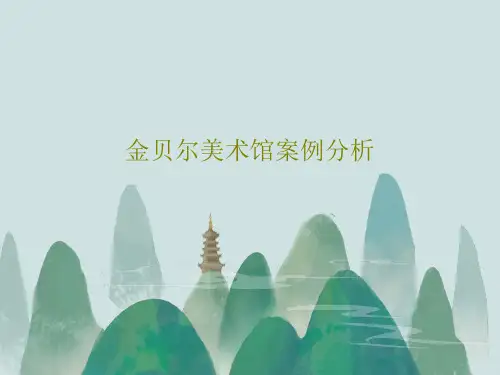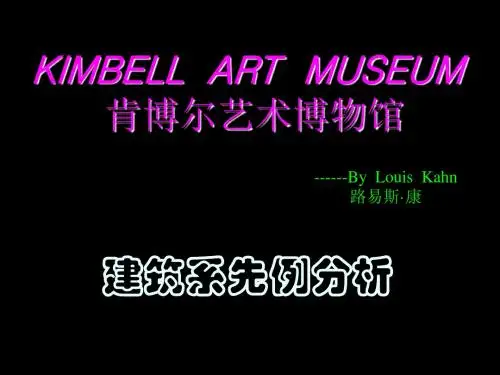肯贝尔艺术博物馆ppt
- 格式:ppt
- 大小:1.93 MB
- 文档页数:31
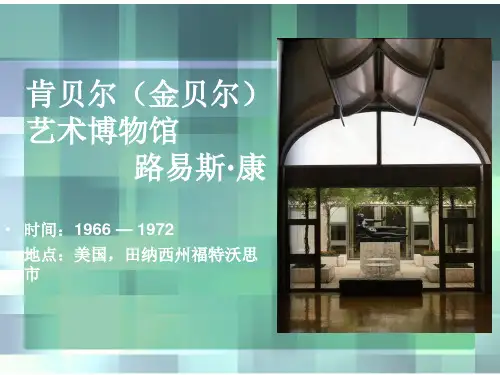

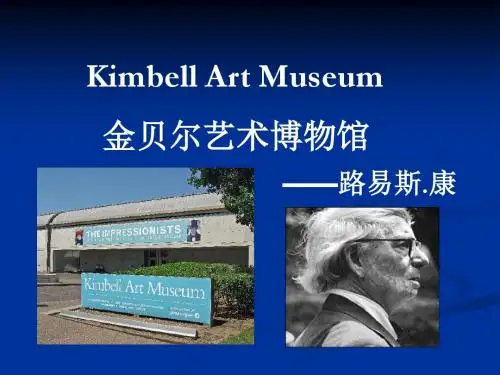
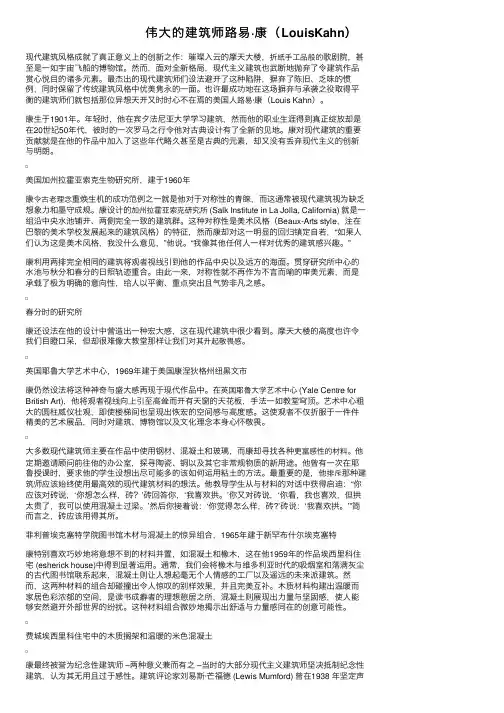
伟⼤的建筑师路易·康(LouisKahn)现代建筑风格成就了真正意义上的创新之作:璀璨⼊云的摩天⼤楼,折纸⼿⼯品般的歌剧院,甚⾄是⼀如宇宙飞船的博物馆。
然⽽,⾯对全新格局,现代主义建筑也武断地抛弃了令建筑作品赏⼼悦⽬的诸多元素。
最杰出的现代建筑师们设法避开了这种陷阱,摒弃了陈旧、乏味的惯例,同时保留了传统建筑风格中优美隽永的⼀⾯。
也许最成功地在这场摒弃与承袭之役取得平衡的建筑师们就包括那位异想天开⼜时时⼼不在焉的美国⼈路易·康(Louis Kahn)。
康⽣于1901年。
年轻时,他在宾⼣法尼亚⼤学学习建筑,然⽽他的职业⽣涯得到真正绽放却是在20世纪50年代,彼时的⼀次罗马之⾏令他对古典设计有了全新的见地。
康对现代建筑的重要贡献就是在他的作品中加⼊了这些年代略久甚⾄是古典的元素,却⼜没有丢弃现代主义的创新与明朗。
美国加州拉霍亚索克⽣物研究所,建于1960年康令古⽼理念重焕⽣机的成功范例之⼀就是他对于对称性的青睐,⽽这通常被现代建筑视为缺乏想象⼒和墨守成规。
康设计的加州拉霍亚索克研究所 (Salk Institute in La Jolla, California) 就是⼀组沿中央⽔池铺开、两侧完全⼀致的建筑群。
这种对称性是美术风格(Beaux-Arts style,注在巴黎的美术学校发展起来的建筑风格)的特征,然⽽康却对这⼀明显的回归镇定⾃若,“如果⼈们认为这是美术风格,我没什么意见,”他说。
“我像其他任何⼈⼀样对优秀的建筑感兴趣。
”康利⽤两排完全相同的建筑将观者视线引到他的作品中央以及远⽅的海⾯。
贯穿研究所中⼼的⽔池与秋分和春分的⽇照轨迹重合。
由此⼀来,对称性就不再作为不⾔⽽喻的审美元素,⽽是承载了极为明确的意向性,给⼈以平衡、重点突出且⽓势⾮凡之感。
春分时的研究所康还设法在他的设计中营造出⼀种宏⼤感,这在现代建筑中很少看到。
摩天⼤楼的⾼度也许令我们⽬瞪⼝呆,但却很难像⼤教堂那样让我们对其升起敬畏感。
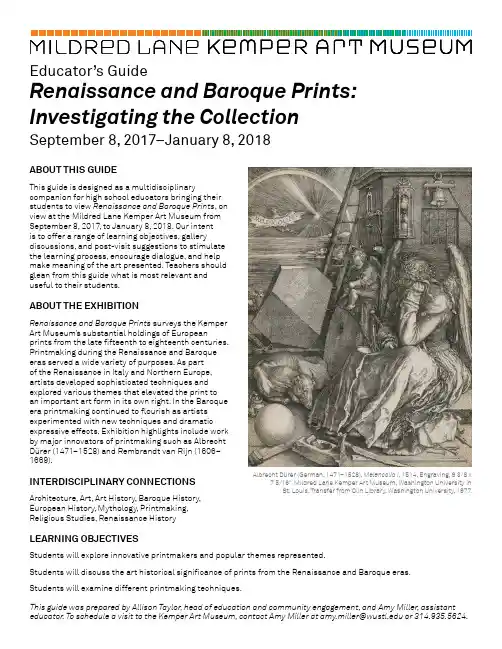
ABOUT THIS GUIDEThis guide is designed as a multidisciplinary companion for high school educators bringing their students to view Renaissance and Baroque Prints , on view at the Mildred Lane Kemper Art Museum from September 8, 2017, to January 8, 2018. Our intent is to offer a range of learning objectives, gallery discussions, and post-visit suggestions to stimulate the learning process, encourage dialogue, and help make meaning of the art presented. Teachers should glean from this guide what is most relevant and useful to their students.ABOUT THE EXHIBITIONRenaissance and Baroque Prints surveys the Kemper Art Museum’s substantial holdings of European prints from the late fifteenth to eighteenth centuries. Printmaking during the Renaissance and Baroque eras served a wide variety of purposes. As part of the Renaissance in Italy and Northern Europe, artists developed sophisticated techniques and explored various themes that elevated the print to an important art form in its own right. In the Baroque era printmaking continued to flourish as artists experimented with new techniques and dramatic expressive effects. Exhibition highlights include work by major innovators of printmaking such as Albrecht Dürer (1471–1528) and Rembrandt van Rijn (1606–1669).INTERDISCIPLINARY CONNECTIONSArchitecture, Art, Art History, Baroque History, European History, Mythology, Printmaking, Religious Studies, Renaissance History LEARNING OBJECTIVESStudents will explore innovative printmakers and popular themes represented.Students will discuss the art historical significance of prints from the Renaissance and Baroque eras.Students will examine different printmaking techniques.Renaissance and Baroque Prints: Investigating the CollectionSeptember 8, 2017–January 8, 2018Educator’s Guide This guide was prepared by Allison Taylor, head of education and community engagement, and Amy Miller, assistant educator.ToscheduleavisittotheKemperArtMuseum,*******************************************.935.5624.Albrecht Dürer (German, 1471–1528), Melencolia I , 1514. Engraving, 9 3/8 x 7 5/16". Mildred Lane Kemper Art Museum, Washington University in St. Louis. Transfer from Olin Library, Washington University, 1977.The rise of printmaking in Europe in the early fifteenth century facilitated a major transformation in visual culture. Serialized images began to circulate on an unprecedented scale, extending beyond the confines of palaces and churches to reach new audiences of artists, collectors, and connoisseurs. The five prints examined on the following pages cover a variety of themes, including mythology, biblical stories, allegory, and everyday life, in addition to printmaking techniques such as engraving, etching, and drypoint.Albrecht Dürer, Melencolia I , 1514German artist Albrecht Dürer (1471–1528) sought to elevate the status of prints and printmaking beyond the level of craft by drawing on new aesthetic systems developed during the Renaissance, such as linear perspective and theories of ideal proportion. Before the Renaissance visual artists were categorized as craftsmen; by capitalizing on his knowledge of mathematics and geometry in the creation of his prints, Dürer helped raise his status from craftsman to intellectual.Melencolia I can be seen as an allegorical self-portrait of Dürer, depicted as a melancholic creative genius who is weighed down by the intellectual processes needed to create great works of art. During Dürer’s time a popular theory identified three types of melancholy. The first type related to the imagination and was understood to affect artists, the second related to reason and was associated with scholars, and the third related to the spirit and was connected to theologians. The winged figure sitting with her head on her hand personifies the new Renaissance artist who could suffer bouts of depression but was also endowed with the capability of intellectual discourse.Discussion QuestionsWhat tools or actions can you see that represent craftsmen? What elements can you see that represent math, science, and the cosmos? What geometric shapes can you find? Discuss the placement of these objects and symbols.What conclusions, if any, can be drawn based on this placement?RENAISSANCE AND BAROQUE ERAS Research the Renaissance and Baroque eras and the importance of both Italy and Northern Europe at these times. What are the dates for these eras? What are the major cultural, intellectual, and artistic issues being explored? What are some innovations that came out of these eras?INTAGLIO PRINTMAKING TECHNIQUES AND ARTISTS Research different printmaking techniques and artists from the Renaissance and Baroque eras. How many techniques can be found? What are the differences between various techniques? What are some printmaking terms and tools? Who are some of the most famous printmaking artists from the Renaissance and Baroque eras? For what are these artists known? What themes were these artists exploring?BEFORE YOU VISIT Suggested topics to explore, research, and discuss before visiting the exhibitionIN THE GALLERYIdeas to consider when viewing the exhibitionDaniel Hopfer (German, c. 1470–1536), The Peasant Feast , c. 1533–36. Etching from two plates, 9 7/8 x 19 5/8". Mildred Lane Kemper Art Museum, Washington University in St. Louis. University purchase, Art Acquisition Fund and with funds from Mrs. Mahlon B. Wallace Jr., and Leicester Busch Faust and AudreyFaust Wallace, by exchange, 2004.Daniel Hopfer, The Peasant Feast , c. 1533–36German artist Daniel Hopfer (c. 1470–1536), a contemporary of Albrecht Dürer, is credited with introducing etching—a technique adapted from the iron trade and armor-making—to the field of printmaking around 1500. Hopfer became a specialist in the technique and is recognized as the first artist to build a significant profession based on this medium.Both the scale and subject of The Peasant Feast , a genre scene showing a group of German peasants celebrating at an annual Catholic Church festival, were new at the time. Hopfer used two plates to create this large-scale horizontal composition depicting excess consumption and unruly behavior. During Hopfer’s time the Lutheran Reformation was taking hold, and while this image can be seen as a critique of the Catholic Church, The Peasant Feast can also be read as celebrating an indigenous German tradition.Discussion QuestionsWhat activities can you identify? What opinions might a contemporary audience glean from a print like this?Hendrick Goltzius, The Great Hercules , 1589German-born Dutch artist Hendrick Goltzius (1558–1617) fell into a fire as a young child, burning his hands on the hot coals, and for the rest of his life could not fully open his right hand. This tragedy makes Goltzius’s accomplishments as a printmaker all the more astonishing.At the time it was made, The Great Hercules was one of the largest prints ever produced from a single engraved copper plate and surpassed all of Goltzius’s previous engravings in size. Mythological images were popular subjects for artists, with the story of Hercules being particularly well known. The most common interpretation of the print is that it represents an elaborate political allegory of the Dutch people’s struggle to overthrow oppressive Spanish rule in what became known as the Dutch Revolt (1568–1648).Discussion QuestionsWhat are some adjectives to describe Hercules’s body? What elements from the Hercules myth can be found? What elements might refer to the Dutch Revolt?Rembrandt van Rijn, The Three Crosses , 1653–1660/61Dutch artist Rembrandt van Rijn (1606–1669) worked in a variety of media and explored a wide range of subject matter during his illustrious career. He often found inspiration in biblical stories from both the Old and New Testaments. Rembrandt’s ability to transform the written word into a powerful pictorial language is evidenced in The Three Crosses .The Three Crosses depicts Christ’s death on the hill of Golgotha amongst dozens of figures—including two crucified thieves—and is inspired by the Gospel of Matthew’s passage about darkness covering the land from noon to three o’clock. Rembrandt would often rework his printing plates, sometimes scraping away entire figures to reposition them or add new ones, and produce several different states of the same print. This practice gave new life to plates that had begun to wear down and became a trademark of Rembrandt’s work. The Kemper Art Museum’s work is the fourth of five states of this print.Discussion QuestionsWhat conclusions, if any, can be drawn by the use of shadows in this print? What conclusions, if any, can be drawn about the size and placement of the various figures?Hendrick Goltzius (Dutch, 1558–1617), The Great Hercules , 1589. Engraving, 22 1/2 x 16 1/4". Mildred Lane Kemper Art Museum, Washington University in St. Louis. University purchase with funds fromMrs. Mahlon B. Wallace Jr., by exchange, 2004.Rembrandt van Rijn (Dutch, 1606–1669), The Three Crosses , 1653–1660/61. Drypoint, 15 1/4 x 17 13/16". Mildred Lane Kemper Art Museum, Washington University in St. Louis. Gift ofDr. Malvern B. Clopton, 1930.Giovanni Battista Piranesi, The Grand Piazza , 1749Italian artist Giovanni Piranesi (1720–1778) admired the history and achievements of the ancient Romans. He earned a reputation for his detailed prints of Italian architecture and ruins, which were sought by eighteenth-century pilgrims, scholars, artists, and tourists as a lasting souvenir of Italy.In addition to prints of existing architecture, Piranesi created different series depicting fanciful buildings and spaces based on his imagination. One highly unusual series of these atmospheric prints called Imaginary Prisons showcases his remarkable inventiveness and deep understanding of construction. In The Grand Piazza , one of Piranesi’s Imaginary Prisons prints, the piazza can be seen through an imposing entrance, displaying the artist’s fascination with architecture and perspective.Discussion QuestionsWhat architectural elements can be identified? How does the scale of the humans and structures affect the reading of this print? What, if any, elements of fantasy can be identified?PRINTMAKING Experiment with different printmaking techniques, tools, and processes. What are some twenty-first-century themes to explore? What are the pros and cons of the different techniques?IN THE CLASSROOM OR AT HOMESuggested activities to follow your visit to the Museum Giovanni Battista Piranesi (Italian, 1720–1778), The Grand Piazza , plate IV from the series Carceri d’invenzione (Imaginary Prisons ), 1749. Etching, 27 5/8 x 21". Mildred Lane Kemper Art Museum, Washington University in St.Louis. Gift of Dr. Malvern B. Clopton, 1935.VOCABULARYallegory – a story told with words or images in which the characters and events are symbols that stand for ideas about human life or for a political or historical situation.Baroque – a style of artistic expression prevalent in the seventeenth and early eighteenth centuries in Europe that is marked by the use of complex forms and bold ornamentation and characterized by extravagance, complexity, or flamboyance.drypoint – a printmaking process that involves scratching a design onto a plate, usually copper, with a sharp round point, which creates a slightly raised ragged edge to the lines. Known as the burr, this rough edge helps to trap the ink and creates rich lines but wears down in successive printings.engraving – a printmaking process, originating in goldsmithery, in which a design is incised onto a metal plate with a cutting tool called a burin. The burin creates a v-shaped groove in the metal to trap ink. Tone and shading can be suggested by making parallel lines or crosshatching.etching – a printmaking process in which a composition is drawn with a needle onto a wax- or resin-coated metal plate. The plate is then soaked in acid, which corrodes the exposed lines of the design and leaves the coating intact. Etching techniques were originally used for decorating armor and other metal objects.ADDITIONAL RESOURCESMarisa Bass, “Hendrick Goltzius: The Great Hercules ,” in Spotlights: Collected by the Mildred Lane Kemper Art Museum , by Sabine Eckmann et al. (St. Louis: Mildred Lane Kemper Art Museum, 2016), 51–55. Also at /node/11289.Paul Crenshaw, “Rembrandt van Rijn: The Three Crosses ,” in Spotlights: Collected by the Mildred Lane Kemper Art Museum , by Sabine Eckmann et al. (St. Louis: Mildred Lane Kemper Art Museum, 2016), 57–60. Also at /node/11317.Ryan Gregg, “Albrecht Dürer: Melencolia I ,” in Spotlights: Collected by the Mildred Lane Kemper Art Museum , by Sabine Eckmann et al. (St. Louis: Mildred Lane Kemper Art Museum, 2016), 41–45. Also at www.kemperartmuseum.wustl. edu/node/11283.“Imaginary Prisons: Giovanni Battista Piranesi Prints,” Princeton University Art Museum, / object-package/giovanni-battista-piranesi-imaginary-prisons/3640.Elizabeth Wyckoff, “Daniel Hopfer: The Peasant Feast ,” in Spotlights: Collected by the Mildred Lane Kemper Art Museum , by Sabine Eckmann et al. (St. Louis: Mildred Lane Kemper Art Museum, 2016), 47–49. Also at /node/11293.There are also many YouTube videos demonstrating various printmaking techniques, particularly those used byAlbrecht Dürer and Rembrandt van Rijn.genre – a representation of scenes or events from everyday life, such as markets, domestic settings, interiors, and street scenes.intaglio – a variety of printmaking techniques—including etching, engraving, and drypoint—in which the image is incised onto a surface and the incised line or sunken area holds the ink. The ink is transferred to paper when pressure is applied.Lutheran Reformation – also known as the Protestant Reformation, a break from the Catholic Church initiated by Martin Luther in 1517.Renaissance – the activity, spirit, or time of the great revival of classical art, literature, and learning in Europe beginning in the fourteenth century and extending to the seventeenth century, marking the transition from the medieval to the modern world. Literally it means rebirth or reawakening.。
